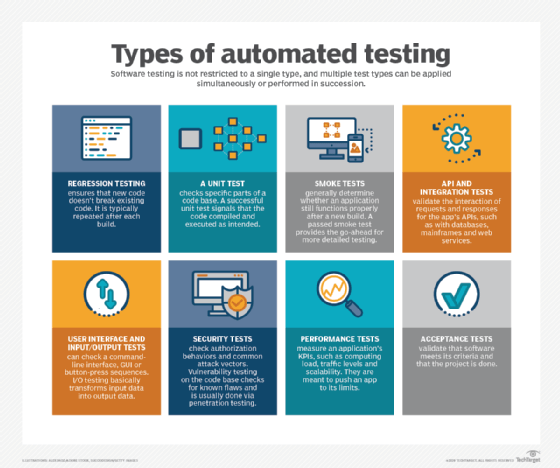Automation Testing Strategies: Best Practices for Seamless Combination
Automation Testing Strategies: Best Practices for Seamless Combination
Blog Article
From Guidebook to Automated Screening: A Comprehensive Overview to Transitioning Efficiently and Properly
In the realm of software program testing, the change from handbook to automated procedures has actually ended up being an increasingly essential shift for companies seeking to boost effectiveness and precision in their testing techniques. The trip from handbook to automated screening is not without its difficulties, yet when approached purposefully and with a clear plan in mind, the advantages can be considerable.
Benefits of Automated Checking
Automated screening offers various advantages, improving performance and precision in software advancement procedures. Automated examinations can be run simultaneously on multiple devices and operating systems, substantially speeding up the testing stage contrasted to manual testing.
In addition, automated screening ensures a greater level of accuracy in discovering flaws. Given that automated examinations adhere to predefined scripts, human error is lessened, causing even more trusted examination outcomes. Uniformity in screening is likewise enhanced, as automated tests perform the exact same steps specifically each time they are run. This consistency is crucial in ensuring that all functionalities of the software are extensively checked, reducing the likelihood of unseen pests slipping through to manufacturing.
Selecting the Right Tools

First of all, evaluate your demands and goals. Comprehend the scope of your task, the technologies involved, and the ability of your group. This analysis will help you establish the capacities and functions you need in your testing devices.
Second of all, think about the compatibility of the tools with your existing procedures and systems. Seamless integration with your existing software program advancement lifecycle is necessary to guarantee a smooth transition to automation.
In addition, examine the scalability and flexibility of the devices. As your screening needs advance, the tools need to have the ability to adapt and suit modifications effectively.
Last but not least, aspect in the support and neighborhood around the devices. When implementing automated screening, durable support and an energetic user neighborhood can provide useful resources and help. By thoroughly taking into consideration these elements, you can pick the right tools that align with your needs and set the stage for an effective transition to automated screening.
Writing Efficient Examination Scripts

When crafting examination scripts, it is important to think about the certain requirements of the software being tested and make certain that the scripts resolve all vital functionalities. Clear and detailed naming conventions for examination manuscripts and test situations can enhance readability and maintainability. Furthermore, including mistake handling mechanisms within the test manuscripts can help in determining and resolving issues immediately.
Furthermore, arranging examination scripts into modular elements can boost reusability and scalability, decreasing redundancy and boosting efficiency in test manuscript upkeep. Normal reviews and updates to evaluate manuscripts are crucial to keep speed with evolving software demands and functionalities. By following these principles, testers can produce durable and reliable test manuscripts that add significantly to the success of automated testing processes.
Integrating Automation Into Workflows
By perfectly incorporating automated testing devices like Selenium or Appium into the software program advancement lifecycle, groups can achieve faster responses on code adjustments, leading to quicker insect discovery and resolution. This combination permits for constant screening throughout the development procedure, guaranteeing that any kind of issues are recognized early on, resulting in higher software application top quality. Appropriate combination of automation tools needs cooperation between advancement, screening, and operations teams to develop a unified workflow that enhances performance and effectiveness in providing high-quality software items.
Ensuring a Smooth Transition
Effectively transitioning to automated screening entails precise preparation and mindful implementation to minimize disturbances and optimize effectiveness in the software development process - automation testing. To guarantee a smooth shift, it is essential to start by conducting a complete analysis of the existing screening procedures and identifying areas where automation can bring the most considerable advantages. Involving with all stakeholders beforehand while doing so, including developers, testers, and project managers, is essential for gathering support and buy-in for the automation initiative
Communication is key during this transition phase. Clear interaction of the objectives, advantages, and assumptions of automated screening assists to handle any type of resistance or issues that may occur. Furthermore, offering appropriate why not check here training and resources for employee to upskill in automation devices and strategies is essential for ensuring a successful change.

Conclusion
In verdict, transitioning from manual to automated screening uses numerous advantages, consisting of increased effectiveness and reliability. By choosing the proper devices, writing effective test scripts, and integrating automation perfectly into process, organizations can guarantee a smooth and effective shift. It is vital to welcome automation as a beneficial property in software program screening procedures to enhance general quality and productivity.
In the realm of software program screening, the change from handbook to automated processes has actually come to be a significantly crucial shift for organizations seeking to boost performance and accuracy in their testing practices. Automated tests can be run simultaneously on numerous tools and operating systems, considerably speeding up the testing stage contrasted to hands-on screening. Uniformity in testing is also boosted, as automated tests execute the very same steps precisely each time they are run.To guarantee the effective application of chosen screening tools, the creation of reliable test manuscripts plays an important function in confirming the performance and performance of automated procedures - automation testing. official website By following these principles, testers can develop efficient and durable test manuscripts that contribute dramatically to the success of automated testing procedures
Report this page